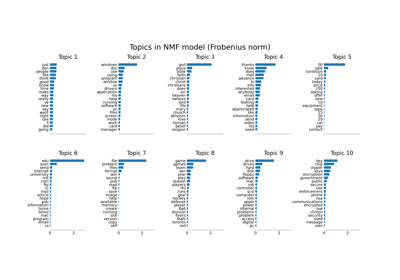LatentDirichletAllocation#
- class sklearn.decomposition.LatentDirichletAllocation(n_components=10, *, doc_topic_prior=None, topic_word_prior=None, learning_method='batch', learning_decay=0.7, learning_offset=10.0, max_iter=10, batch_size=128, evaluate_every=-1, total_samples=1000000.0, perp_tol=0.1, mean_change_tol=0.001, max_doc_update_iter=100, n_jobs=None, verbose=0, random_state=None)#
潜在狄利克雷分配与在线变分贝叶斯算法。
该实现基于[Re25e5648fc37-1]_和[Re25e5648fc37-2]_。
Added in version 0.17.
更多信息请参阅 用户指南 。
- Parameters:
- n_componentsint, default=10
主题数量。
Changed in version 0.19:
n_topics被重命名为n_components- doc_topic_priorfloat, default=None
文档主题分布
theta的先验。如果该值为 None,则默认为1 / n_components。 在 [1] 中,这被称为alpha。- topic_word_priorfloat, default=None
主题词分布
beta的先验。如果该值为 None,则默认为1 / n_components。 在 [1] 中,这被称为eta。- learning_method{‘batch’, ‘online’}, default=’batch’
用于更新
_component的方法。仅在fit方法中使用。 一般来说,如果数据量较大,在线更新会比批量更新快得多。有效选项:
'batch': 批量变分贝叶斯方法。在每次 EM 更新中使用所有训练数据。 每次迭代中会覆盖旧的 `components_` 。 'online': 在线变分贝叶斯方法。在每次 EM 更新中,使用训练数据的小批量来逐步更新 ``components_`` 变量。 学习率由 ``learning_decay`` 和 ``learning_offset`` 参数控制。Changed in version 0.20: 默认学习方法现在是
"batch"。- learning_decayfloat, default=0.7
控制在线学习方法中学习率的参数。该值应设置在 (0.5, 1.0] 之间以保证渐近收敛。 当该值为 0.0 且 batch_size 为
n_samples时,更新方法与批量学习相同。 在文献中,这被称为 kappa。- learning_offsetfloat, default=10.0
在线学习中对早期迭代进行降权的正参数。它应大于 1.0。 在文献中,这被称为 tau_0。
- max_iterint, default=10
训练数据的最大遍历次数(即 epochs)。 它仅影响
fit方法的行为,不影响partial_fit方法。- batch_sizeint, default=128
每次 EM 迭代中使用的文档数量。仅在在线学习中使用。
- evaluate_everyint, default=-1
评估困惑度的频率。仅在
fit方法中使用。 将其设置为 0 或负数以不在训练过程中评估困惑度。 评估困惑度可以帮助您检查训练过程中的收敛情况,但也会增加总的训练时间。 在每次迭代中评估困惑度可能会使训练时间增加一倍。- total_samplesint, default=1e6
文档总数。仅在
partial_fit方法中使用。- perp_tolfloat, default=1e-1
困惑度容忍度。仅在
evaluate_every大于 0 时使用。- mean_change_tolfloat, default=1e-3
在 E-step 中更新文档主题分布的停止容忍度。
- max_doc_update_iterint, default=100
E-step 中更新文档主题分布的最大迭代次数。
- n_jobsint, default=None
在 E-step 中使用的作业数量。
None表示 1,除非在joblib.parallel_backend上下文中。-1表示使用所有处理器。更多详情请参阅 术语表 。- verboseint, default=0
详细程度。
- random_stateint, RandomState 实例或 None, default=None
传递一个 int 以在多次函数调用中获得可重复的结果。 更多详情请参阅 术语表 。
- Attributes:
- components_ndarray of shape (n_components, n_features)
主题词分布的变分参数。由于主题词分布的完全条件是狄利克雷分布,
components_[i, j]可以被视为表示词j被分配给主题i的次数的伪计数。 它也可以被视为每个主题的词分布在归一化后的分布:model.components_ / model.components_.sum(axis=1)[:, np.newaxis]。- exp_dirichlet_component_ndarray of shape (n_components, n_features)
对数主题词分布期望的指数值。 在文献中,这被称为
exp(E[log(beta)])。- n_batch_iter_int
EM 步骤的迭代次数。
- n_features_in_int
在 fit 过程中看到的特征数量。
Added in version 0.24.
- feature_names_in_ndarray of shape (
n_features_in_,) 在 fit 过程中看到的特征名称。仅当
X的特征名称均为字符串时定义。Added in version 1.0.
- n_iter_int
数据集的遍历次数。
- bound_float
训练集上的最终困惑度得分。
- doc_topic_prior_float
文档主题分布
theta的先验。如果该值为 None,则为1 / n_components。- random_state_RandomState 实例
生成的 RandomState 实例,可以是来自种子、随机数生成器或
np.random。- topic_word_prior_float
主题词分布
beta的先验。如果该值为 None,则为1 / n_components。
See also
sklearn.discriminant_analysis.LinearDiscriminantAnalysis一种具有线性决策边界的分类器,通过拟合类条件密度到数据并使用贝叶斯规则生成。
References
[1] (1,2)“Online Learning for Latent Dirichlet Allocation”, Matthew D. Hoffman, David M. Blei, Francis Bach, 2010 blei-lab/onlineldavb
[2]“Stochastic Variational Inference”, Matthew D. Hoffman, David M. Blei, Chong Wang, John Paisley, 2013
Examples
>>> from sklearn.decomposition import LatentDirichletAllocation >>> from sklearn.datasets import make_multilabel_classification >>> # 这将生成一个词频特征矩阵,类似于 >>> # CountVectorizer 在文本上的输出。 >>> X, _ = make_multilabel_classification(random_state=0) >>> lda = LatentDirichletAllocation(n_components=5, ... random_state=0) >>> lda.fit(X) LatentDirichletAllocation(...) >>> # 获取某些样本的主题: >>> lda.transform(X[-2:]) array([[0.00360392, 0.25499205, 0.0036211 , 0.64236448, 0.09541846], [0.15297572, 0.00362644, 0.44412786, 0.39568399, 0.003586 ]])
- fit(X, y=None)#
使用变分贝叶斯方法对数据X进行模型训练。
当
learning_method为’online’时,使用小批量更新。 否则,使用批量更新。- Parameters:
- X{类数组,稀疏矩阵},形状为(n_samples, n_features)
文档词矩阵。
- y被忽略
不使用,按惯例在此处存在以保持API一致性。
- Returns:
- self
拟合的估计器。
- fit_transform(X, y=None, **fit_params)#
拟合数据,然后进行转换。
将转换器拟合到
X和y,并带有可选参数fit_params, 并返回X的转换版本。- Parameters:
- X形状为 (n_samples, n_features) 的类数组
输入样本。
- y形状为 (n_samples,) 或 (n_samples, n_outputs) 的类数组, 默认=None
目标值(无监督转换为 None)。
- **fit_paramsdict
其他拟合参数。
- Returns:
- X_new形状为 (n_samples, n_features_new) 的 ndarray 数组
转换后的数组。
- get_feature_names_out(input_features=None)#
获取转换后的输出特征名称。
输出特征名称将以小写的类名作为前缀。例如,如果转换器输出3个特征,那么输出特征名称将是:
["class_name0", "class_name1", "class_name2"]。- Parameters:
- input_features类似数组的对象或None,默认为None
仅用于验证特征名称与
fit中看到的名称。
- Returns:
- feature_names_outndarray of str对象
转换后的特征名称。
- get_metadata_routing()#
获取此对象的元数据路由。
请查看 用户指南 以了解路由机制的工作原理。
- Returns:
- routingMetadataRequest
MetadataRequest封装的 路由信息。
- get_params(deep=True)#
获取此估计器的参数。
- Parameters:
- deepbool, 默认=True
如果为True,将返回此估计器和包含的子对象(也是估计器)的参数。
- Returns:
- paramsdict
参数名称映射到它们的值。
- partial_fit(X, y=None)#
在线 VB 使用小批量更新。
- Parameters:
- X{array-like, sparse matrix},形状为 (n_samples, n_features)
文档词矩阵。
- y忽略
未使用,此处存在是为了通过约定保持 API 一致性。
- Returns:
- self
部分拟合的估计器。
- perplexity(X, sub_sampling=False)#
计算数据 X 的近似困惑度。
困惑度定义为 exp(-1. * 每词的对数似然)
Changed in version 0.19: doc_topic_distr 参数已被弃用且被忽略,因为用户不再能够访问未归一化的分布
- Parameters:
- X{array-like, sparse matrix} of shape (n_samples, n_features)
文档词矩阵。
- sub_samplingbool
是否进行子采样。
- Returns:
- scorefloat
困惑度得分。
- score(X, y=None)#
计算近似对数似然作为分数。
- Parameters:
- X{array-like, sparse matrix} of shape (n_samples, n_features)
文档词矩阵。
- yIgnored
未使用,此处仅为遵循API一致性。
- Returns:
- scorefloat
使用近似边界作为分数。
- set_output(*, transform=None)#
设置输出容器。
请参阅 介绍 set_output API 以了解如何使用API的示例。
- Parameters:
- transform{“default”, “pandas”, “polars”}, 默认=None
配置
transform和fit_transform的输出。"default": 转换器的默认输出格式"pandas": DataFrame 输出"polars": Polars 输出None: 转换配置不变
Added in version 1.4:
"polars"选项已添加。
- Returns:
- self估计器实例
估计器实例。
- set_params(**params)#
设置此估计器的参数。
该方法适用于简单估计器以及嵌套对象(例如
Pipeline)。后者具有形式为<component>__<parameter>的参数,以便可以更新嵌套对象的每个组件。- Parameters:
- **paramsdict
估计器参数。
- Returns:
- selfestimator instance
估计器实例。
- transform(X)#
根据拟合的模型转换数据X。
Changed in version 0.18: doc_topic_distr 现在已归一化
- Parameters:
- X{array-like, sparse matrix} of shape (n_samples, n_features)
文档词矩阵。
- Returns:
- doc_topic_distrndarray of shape (n_samples, n_components)
X的文档主题分布。


